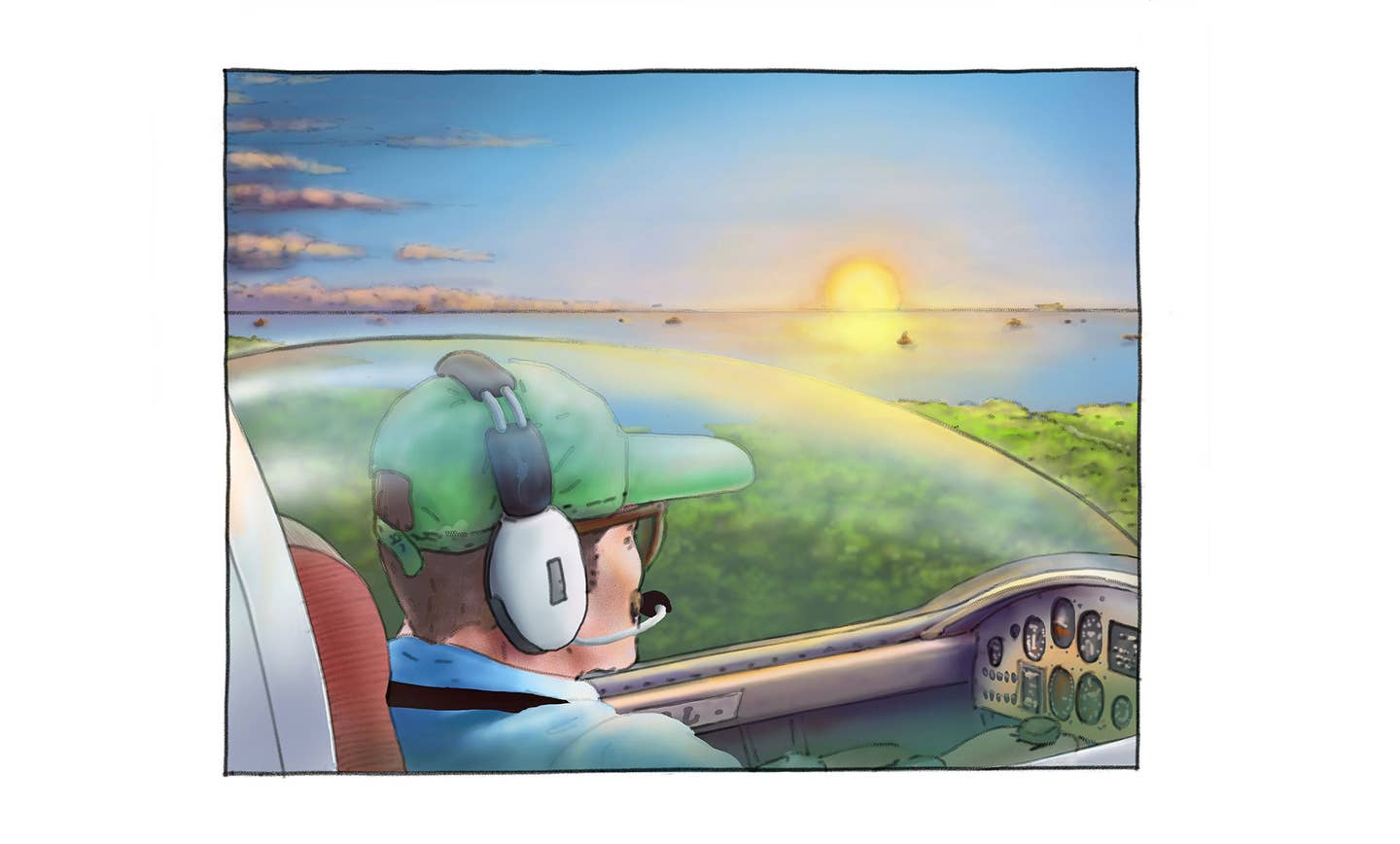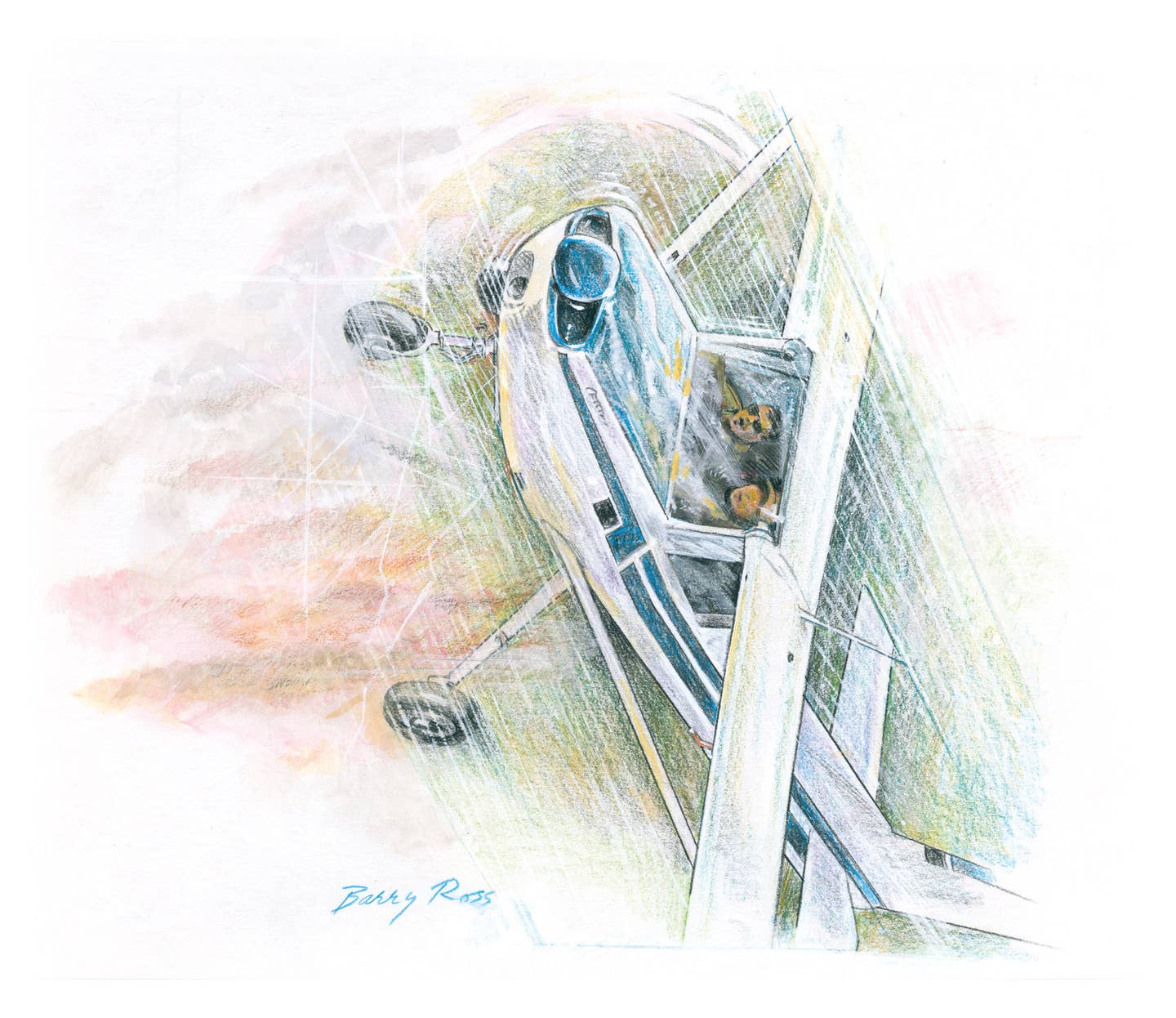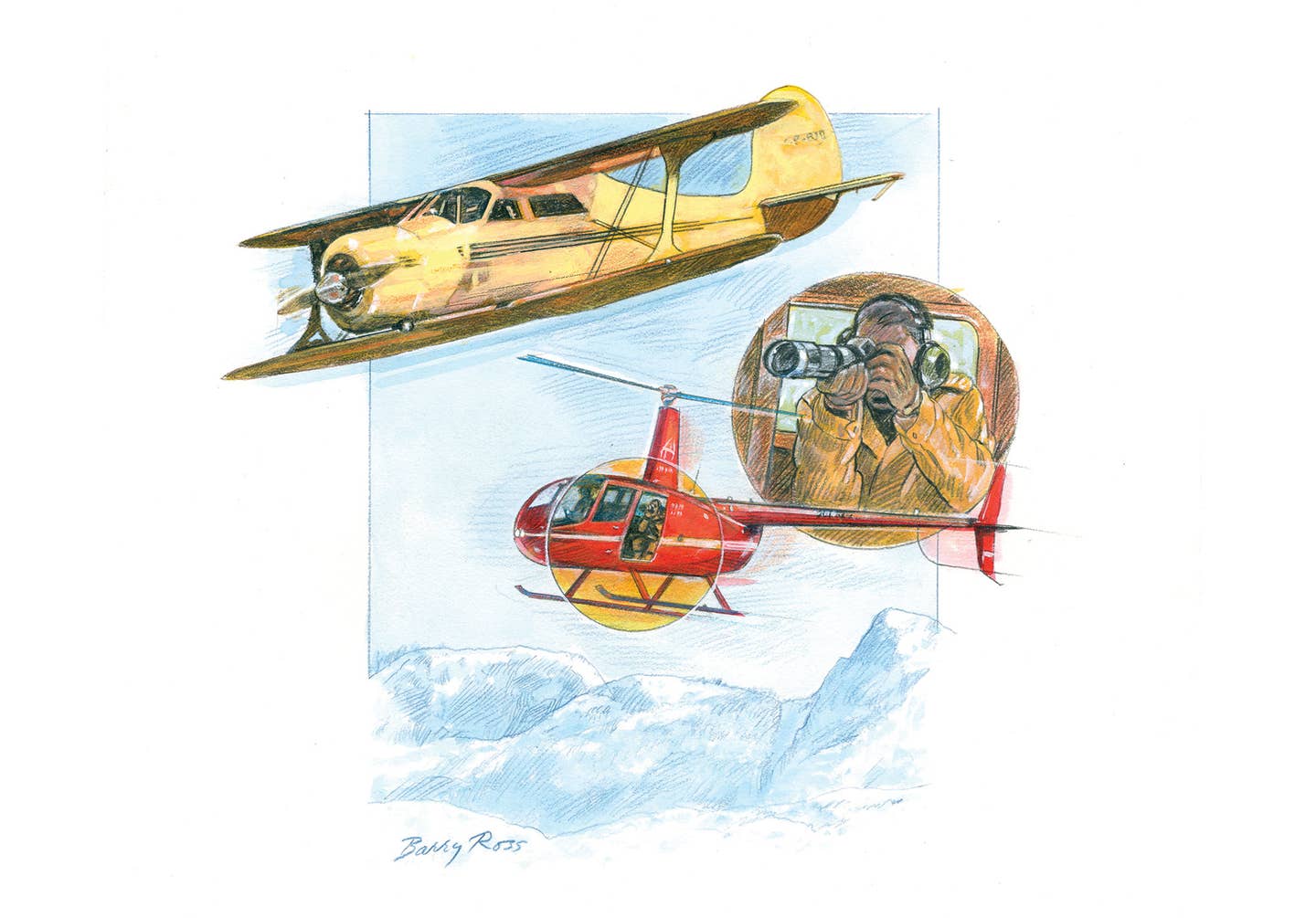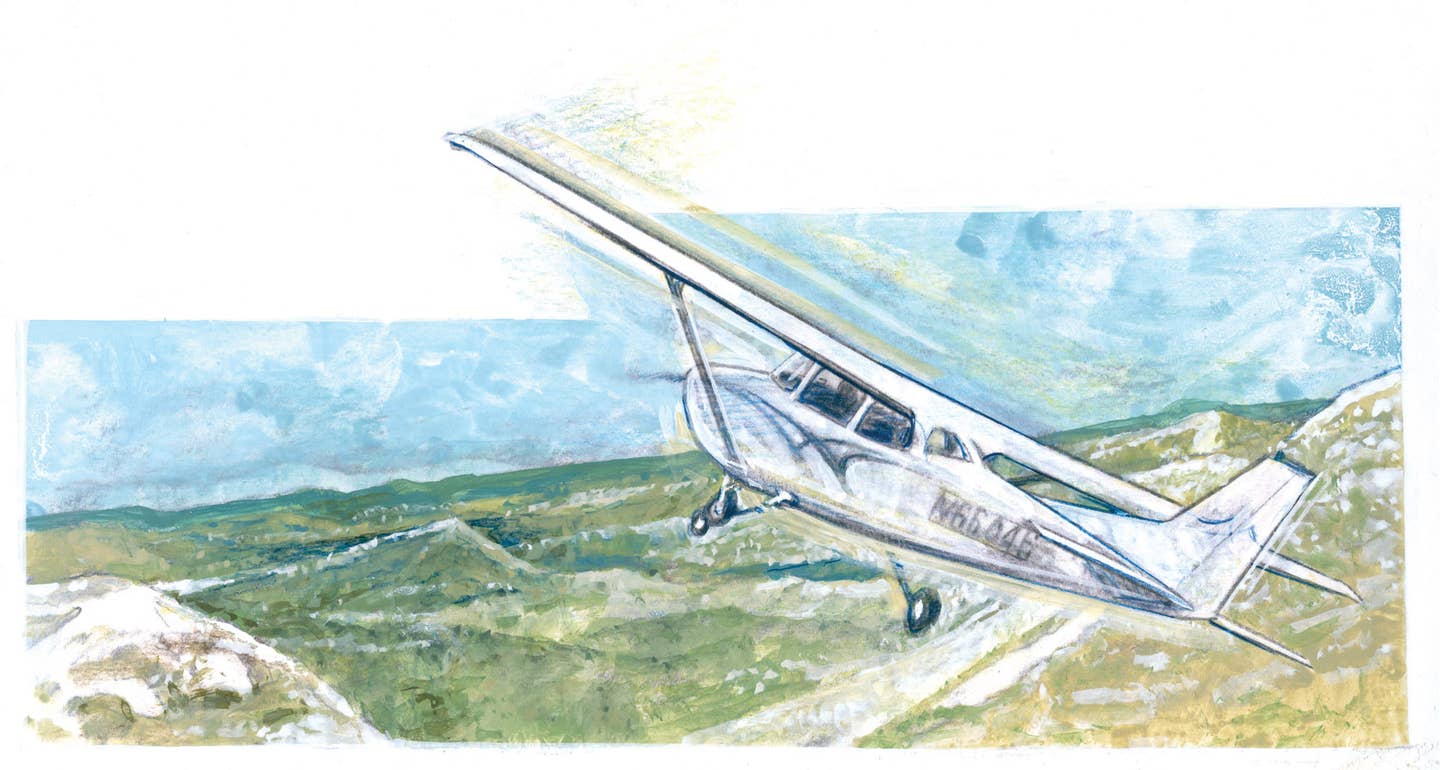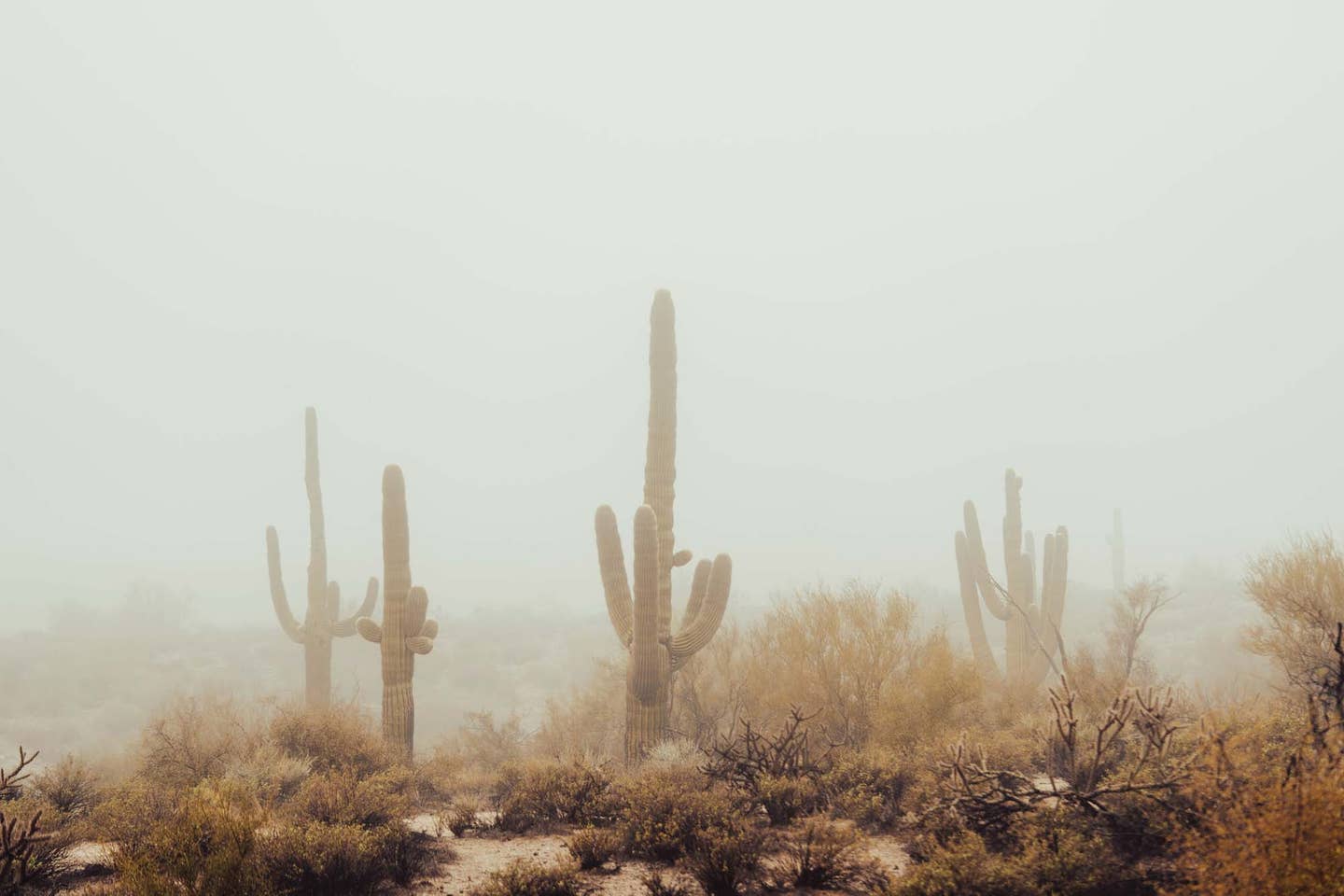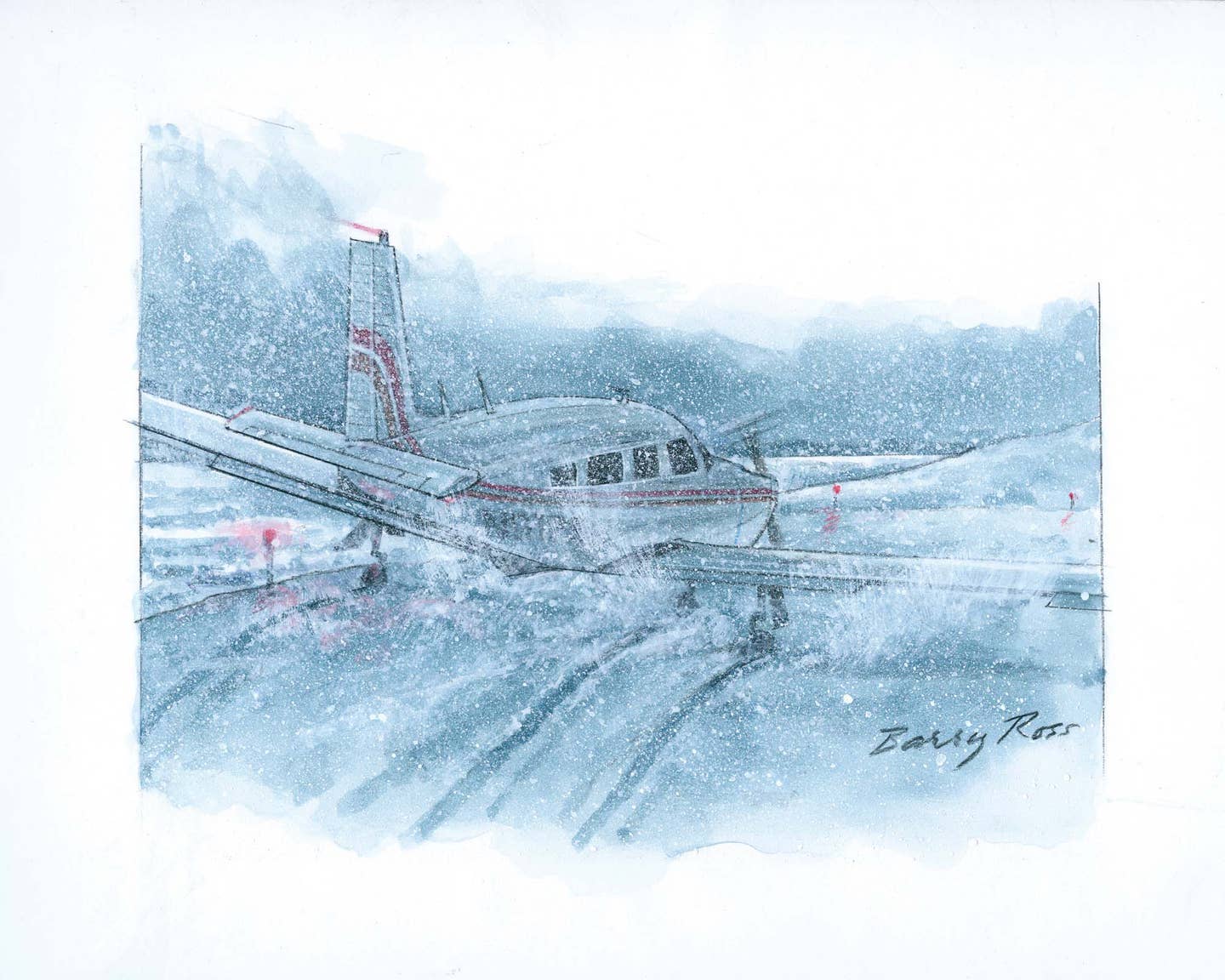Lessons Learned: Achieving Aspirations
Ray Andrews, my flight instructor, turned to me and asked, “So, you think you’re ready to solo in front of your friends?” After my half-hour flight lesson of three takeoffs…
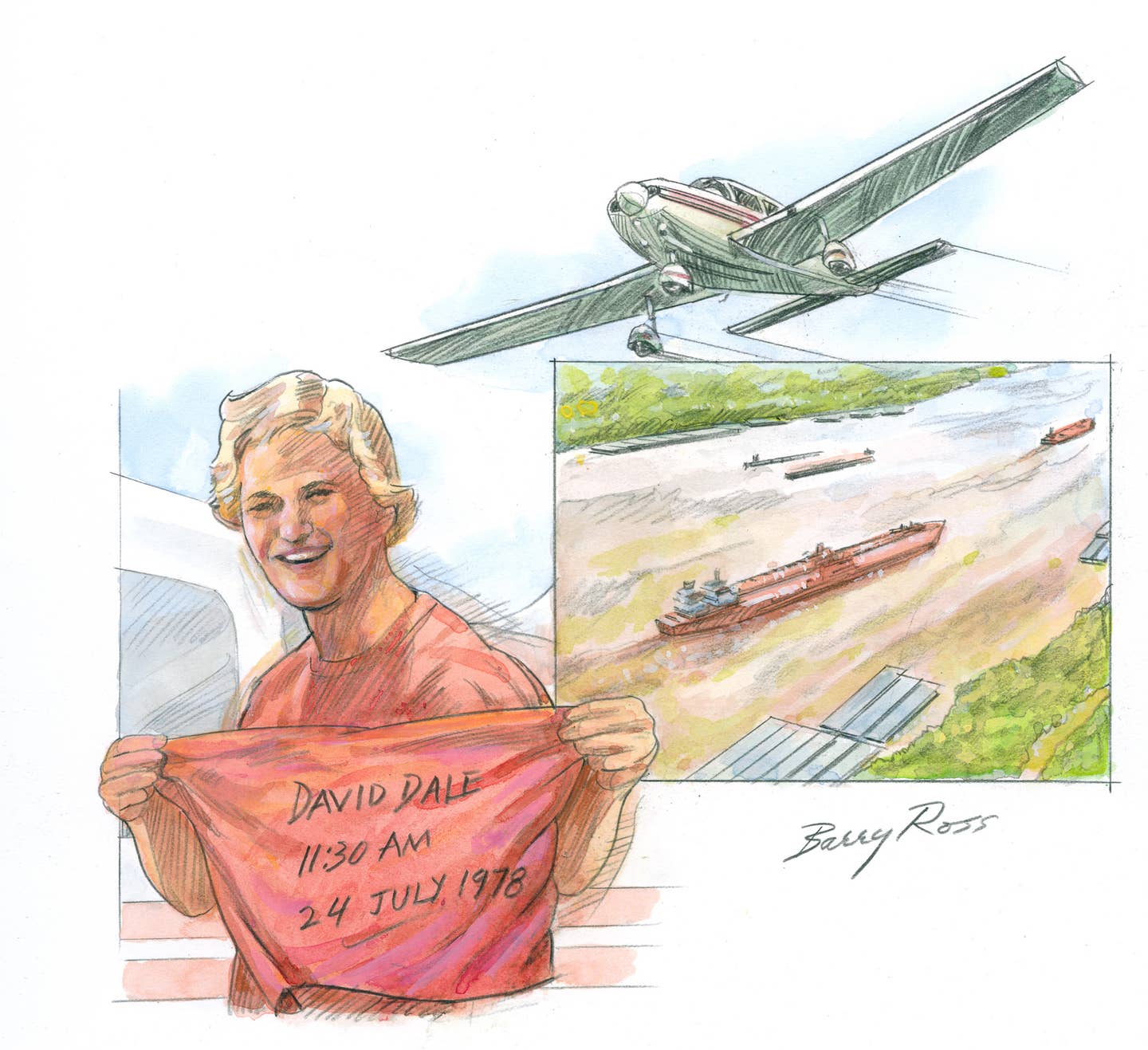
[Illustration: Barry Ross]
Ray Andrews, my flight instructor, turned to me and asked, “So, you think you’re ready to solo in front of your friends?”
After my half-hour flight lesson of three takeoffs and landings, with my childhood friends Larry Leonard and Michael Rafferty watching from alongside the grassy airstrip, I was surprised by his question. I had no idea this might be “the day” I would solo at Weiser Airpark (formerly KEYQ) outside of Houston. I don’t remember what I answered, but I think I just smiled and nodded. Up to this point, I had seven hours of flight instruction and performed a total of 42 takeoffs and landings.
Andrews climbed out of the right seat of the Piper Cherokee, and I taxied to the end of the runway for what would be my 15-minute solo flight, performing three touch-and-go landings with Michael and Larry snapping away with a yellow Kodak disposable camera.
My main memory of the flight is that when I looked left and then right, ensuring the path was clear before making a turn, there was nobody sitting to my right in the cockpit. I was alone. Even as nervous as I was, I was also very excited.
Like a lot of teenagers growing up, I enjoyed going to airshows. At one point in the 1970s, both the Air Force Thunderbirds and the Navy Blue Angels flew the F-4 Phantom as they put on airshows throughout the country. As they performed beautiful diamond formation rolls and loops, trailing the ever-present tail of white smoke, or crossed show center cockpit-to-cockpit, I thought, “That is one bad-ass airplane.”
- READ MORE: Lessons Learned – To Hell You Fly
Air Force flying was in my family. My uncle, Jack Sanders, was an Air Force fighter pilot, flying the F-100 Super Sabre during the Vietnam War. He then flew the A-7 Corsair II and finally transitioned to the new A-10 Thunderbolt II tank killer. He was an A-10 squadron commander, the pinnacle of a fighter pilot’s career, before helping to set up a new squadron of A-10s at Eielson Air Force Base, Alaska, during the Cold War (no pun intended). He closed out his 30-year career as a colonel and vice commander of First Air Force in Tactical Air Command at Langley AFB, Virginia, during Operation Desert Storm in the 1990s.
In 1979, Uncle Jack was a lieutenant colonel and A-10 squadron commander at Davis-Monthan AFB, outside of Tucson, Arizona. That spring, I was 17 years old and went to visit my Uncle Jack, Aunt Elaine, and two cousins, Christy and Tina. During that trip, I got to tour the base control tower and from a bird’s-eye view watched the fighters take off and land. One of the highlights of my visit was when Uncle Jack arranged for me to fly the A-7 simulator. I pretended to be a fighter pilot as I simulated low-altitude strafing attacks.
I came home from that trip determined to be a fighter pilot. I started flying lessons a year earlier in June 1978 at the grass runway of Weiser Airpark (which would eventually close in 2019). I signed up for the Piper Flight School and gave the instructor $700, which he would draw from after each lesson. In hindsight, it worked to Andrews’ advantage for me to solo quickly because the quicker I soloed, the more money he kept.
Weiser Airpark had two World War II-era AT-6 Texan trainers on the grass field. Larry and Michael enjoyed airplanes as much as I did, so I invited them along for my seventh lesson—and that’s when I soloed. After landing for the third and final time, I climbed out of the Piper Archer and took part in the ritual of having my shirttail (tail feathers) cut off. The only problem was that I was wearing my sister’s favorite surfer T-shirt, a cool red one with an ocean wave on the front. Oops.
My name, the time, and date of the flight, July 24, 1978, were written in black Marks-A-Lot on the cutoff portion of the shirt and tacked to the wall of the flight school. I have no memory of what happened next. I guess my brain was so focused on the momentous solo flight. Larry and Michael tell me that Andrews then offered for them to join us on one more flight. The four of us, Andrews included, took off once again around the pattern with me at the controls.
The rest of my flight lessons took place at La Porte Municipal Airport (T41) in Pasadena, Texas, located near the oil refineries along the ship channel east of Houston. We called this area “Stinkadena,” because of the foul oil aroma, referred to in the Lone Star State as the smell of money. I worked as a busboy and cook at The Mason Jar Restaurant near my house on the west side of Houston to pay for my flying lessons. In addition, I joined the Aviation Explorers Post, a coed branch of Boy Scouts that focused on aviation.
My flight instructor for Aviation Explorers was Richard Lovell. He was the owner of a beautiful 180 hp 1973 Piper Challenger, a white four-seater with a black-and-gray stripe down the side. Lovell served in the Navy during the Korean War but not as a pilot, and he didn’t deploy overseas. He laughed about earning the National Defense Service Medal for never going anywhere. He was a short, tough old man—a Navy boxing champ with a permanently crooked nose to prove it. Day in and day out, he dipped Copenhagen and swallowed it. During flying lessons over the Texas Gulf Coast, as he gave me instructions, he’d suddenly let out a burp, filling the cockpit with the smell of the snuff. To this day, my Pavlovian response is to equate the smell of dipping tobacco with a Piper four-seater.
- READ MORE: A Father Goes Flying With The Kid
I owe Lovell a lot. He was demanding, telling me to “fight for centerline” when landing in a crosswind. As tough as he was, he was also very kind. Lovell donated his instructor time for free, as a way of giving back to the Scouts program. My flight lessons from 1978 to 1980 started at $22 an hour and eventually rose to $25. This came at a time of high inflation, when certificates of deposits earned 13 percent, and I was making around $3 an hour at the restaurant.
The hour-long lessons, flown near the Houston Ship Channel, consisted of air work, flying 360-degree turns, keeping my wingtip pointed at a blue, lollipop-shaped water tower below while adjusting for the wind changes, or making a series of S-turns over a railroad track. These exercises taught me to take the varying winds into account.
Stalling an airplane can be a pilot’s nightmare—even in practice. To build my confidence, Lovell demonstrated his Piper’s ability to handle a stall. Reducing the throttle to idle, pulling the yoke back to his chest, this Copenhagen-dipping instructor proceeded to illustrate the magical gift of his aircraft. As I watched the airspeed bleed off, the stall warning light and buzzer distracting my attention, I noticed his hands suddenly release the straining yoke of the shuddering airplane. My heart and stomach raced each other for my throat as the airplane transferred from 30 degrees nose high into a steep dive.
“Crap!” I exclaimed as I looked down on the offshore drilling rig growing larger in front of the propeller. Without touching the controls, the airspeed increased and the trusty Cherokee slowly pitched up and down, finally settling at the original level-flight attitude. This breathtaking demonstration of aerodynamic stability allowed me to confidently rehearse stall recoveries on my own.
Thanks to Lovell’s instruction, encouragement, and generosity, I was ready for my private check ride on August 20, 1980. I spent that afternoon with a renowned FAA-designated evaluator, Maybelle Fletcher, who was a fixture in the Houston aviation community. At the time, she and her husband operated Fletcher Aviation at Hobby Airport (KHOU) south of downtown Houston. This nerve-wracking day began when I flew solo from quiet, tiny La Porte airport into busy Hobby. An 18-year-old kid in a small, single-engine propeller plane had to fly into a big-city airport, sequenced between Learjets and brightly colored Braniff Airways 727s.
- READ MORE: Hangin’ Out in Austin
With that behind me, I then underwent Fletcher’s oral ground evaluation. Finally, we flew a one-hour flight to an outlying airport for three touch-and-go landings. With my check ride complete, I was now a certificated private pilot just one week from starting college at the University of Texas at Austin.
It had been an exciting day, but I still needed to fly back to La Porte. It was 4 p.m. by the time I was debriefed and congratulated by Fletcher. I sat in my small plane near the end of the Hobby runway, waiting for my turn to take off. But this was “rush hour,” and streams of Learjets and airliners continued to land.
Just before being cleared for takeoff, the Piper’s engine began to sputter. It had a left and right fuel tank, one in each wing, with a fuel selector by my left knee. Since most of my flying lessons lasted just one hour, switching fuel tanks was rarely required. On this day, however, the engine had already been running for nearly three hours, and the left fuel tank was almost dry.
Distracted by the excitement of passing my check ride and impatiently watching the landing jets, I forgot to switch fuel tanks. I quickly threw the selector to the right wing tank, and the engine continued running. Fortunately, I had not been cleared for takeoff a minute sooner or the engine would have quit during takeoff. That would have been a very short aviation career.
—From the aviation memoir ‘Ready For Takeoff: Stories from an Air Force Pilot’
Editor's Note: This story originally appeared in the November/December 2023 issue of Plane & Pilot magazine.

Subscribe to Our Newsletter
Get the latest Plane & Pilot Magazine stories delivered directly to your inbox

